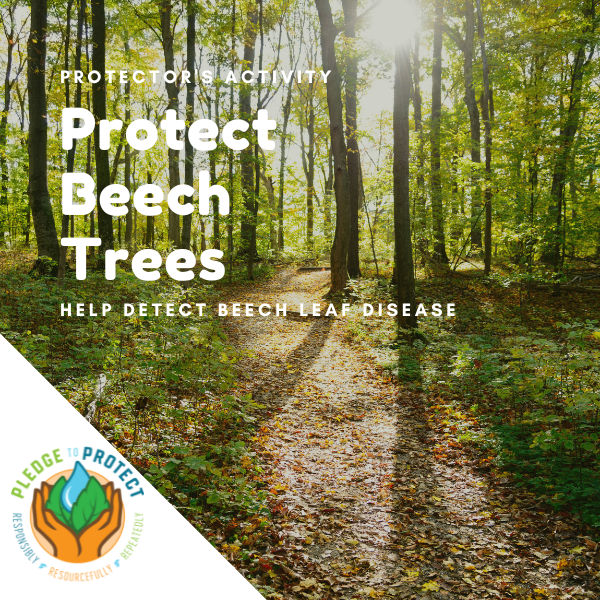A special thank you to Maria MoskaLee- NYS DEC Forest Health Specialist & Field Crew Supervisor for contributing to this blog.
What's The Issue?
Beech leaf disease (BLD) is the newest threat to beech trees and is spreading rapidly across the Northeastern United States and Canada.
Both native and ornamental beech tree species are affected by BLD and symptoms are believed to be caused by the nematode Litylenchus crenatae mccannii. It is unknown whether the nematode causes all of the damage, or if it is associated with another pathogen such as a bacteria, fungus, or virus. Research on possible treatments is ongoing.
BLD was first observed in the U.S. in 2012 in Ohio. It has since spread across the Northeastern United States and Canada and has recently been found in 15 new counties within New York state, including Oswego.
American beech trees are an important component of the northern hardwood forest type (maple-beech-birch) which makes up more than half of the forested land in New York. Many wildlife species rely on beech mast as a main source of energy. The loss of beech trees would cause changes in forest structure that would affect the whole ecosystem.
What Can Be Done?
- There is a state-wide effort to track the spread of beech leaf disease. You can help by learning to recognize symptoms of the disease and report observations to iMapInvasives.org-New York’s invasive species observation database.
- Take hikes and inspect beech tree leaves for signs of BLD.

Enjoy a guided walk in the woods, and learn to recognize and report Beech Leaf Disease.
- When: Tuesday, September 20th, 1-3 pm
- Where: Joseph Blake Bird Sanctuary in Rutland/Champion, NY.
What to Look For
BLD symptoms appear in the leaves and include striping, curling, or a leathery texture. These signs may be visible year-round, as some beech trees may hold their leaves in winter. Stripes are most noticeable on the underside of leaves and you may see them by looking up into the canopy or holding branches up to the light. Eventually, affected leaves wither, dry, and yellow (NYSDEC).
- Stripping on leaves is most visible from the underside.
- Hold leaves up to the light to look for dark strips along the veins.
- Some infested trees only have a few leaves that show symptoms so search carefully throughout the canopy.

Since so much about beech leaf disease is unknown, learning of new infestations aids research and management efforts. Reports in counties where BLD has been newly found and in counties where it has not been found are especially needed.
If you think you have found beech leaf disease follow these steps:
- Take photos of symptoms, as well as the tree’s leaves, bark, and the entire tree if possible. Photos of leaves held up to the light or taken through the canopy, make it easier to identify BLD symptoms.
- Submit a report through iMapInvasives Beech leaf disease is listed as the nematode Litylenchus crenatae maccannii.

Identifying Beech Trees
BARK

- Beech tree bark is gray in color & usually smooth in texture (left photo).
- The bark of a beech tree infested with beech scale may have scattered woolly spots on the tree trunk (middle photo).
- Beech scale may lead to an infestation of different fungi that combined with the presence of the scale result in beech bark disease which causes the bark to have bumps and cankers (right photo).
Leaves

- Beech leaves are ovate; every leaf vein ends in a tooth, and leaves are not hairy (right leaf pictured above).
- Eastern hophornbeam has a similar leaf but there are teeth along the edge that are not at the end of a leaf vein (left leaf pictured above).
Did you enjoy this blog post? Take our Pledge to Protect and get monthly emails showcasing actions you can take to protect your favorite hiking trails, paddleways, forests, garden, and community from the impacts of invasive species!
Take the Pledge to Protect
The Pledge-to-Protect is a fun, positive, inviting, engaging and rewarding way to participate in invasive species prevention and management.
|
|



